 |
An
Introduction to Brazilian Orchidophilia by Raimundo Mesquita |
A methodological question Which orchidophilia we will talk about? The etymology does not help a lot because the meaning of orchidophilia, which comes from the Greek orchidos + filein (that means, more or less, love orchids), leads us to the same perplexity, in other words, expression too much undefined and generic that gives the impression that who loves orchids, even if he does not cultivate them, is an orchidophile ... So, Brazilian orchidophilia means that all residents in Brazil and Brazilian people love orchids? It could be due to the charm and fascination those plants somewhat mysterious, surrounded by enchantment, exercise on people. |
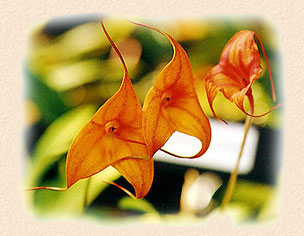 |
Until now, I have never met someone who, even
if he is not a cultivator or a flower loved, says that he does not love orchids. We find who does not love this or that genus even among orchids lovers (mainly if is someone who does not succeed in cultivate it adequately...), and, in this particular case, the poor Masdevallia seems to be the champion of displeasure in Brazil. Then, so what? |
Let's try to put an order in this chaos. It seems to me that there is just one way to face the dilemma placed above that, as all sophisms, tends to block my capacity of going on this route where I try to draft a small critical introduction to Brazilian orchidophilia. The only way is to say, at once, what orchidophilia means to me, what does it intends to signify to my aim of delineating an unavoidable and inevitably incomplete Brazilian orchidophilia panorama, or in other words, how, through the handling and cultivation, the way orchids is dealt in Brazil as an object of research or of trade, knowledge, ornamentation or pleasure, this enumeration does not mean an preferential order or origin. I will talk about brotherhood, corporation, secret society, briefly, about amateurs clubs and cultivators, who formed this particular being called orchidophile because there is not orchidophile without a orchodiphile society. It can, even, exist an alone orchid grower but he is put in the category of flower cultivator, never an orchidophile, since he will not have the "linguage of the tribe", he will never have the anxious search of the most beautiful flowers, he will never have the contempt for the beautiful plants but ordinary, without the forms that satisfy the best standards of the different systems of judgment, he will not have the desire for an unique plant, etc. etc.... Thus, the orchidophilia I will talk about is the orchidophilia we practice by the close association between people who love, cultivate and make orchids their motive of pleasure and knowledge. What did it start? I do not know if we can say, with the historical accuracy, that Brazilian orchidophilia started in a certain time, in this or in that way. There is no researches and I am convinced that there are no believable registers to be consulted. At least, I did not find them in the researches I have done, included in National Library, before the World Orchid Conference and that gave me material to some publications in Orquidário. There are, certainly, some spread information and some registers which pointed out that the interest to orchids started, almost contemporarily with the European orchid culture (as always happens in Brazil...), due to the cultural interchange between the rich élites or due to the acquaintanceship of Brazilian people with foreign collects who were sent here, in the interest of the science and the European flowers trade. On the other hand, there is a national versant of scientific interest, that had, no doubt about, an expressive importance in the development the Brazilian orchidophilia: Father Velloso, Alexandre Rodrigues Ferreira, Freire Alemão, Barbosa Rodrigues, Hoehne and, more recently, in the spread of the knowledge and the know how to cultivate them, João Decker, Waldemar Silva and Mercedes Silva Ramos (I think it would be worth and useful to do a critical catalogue of the Brazilian bibliography about orchids). In a second stage and already settled, so to speak, the interest, the inclination for the cultivation increases from the cession or exchange of Brazilian species for foreign genera and species such as the Brazilian growers did with the sailors working in foreign merchant ships that docked in our ports. |
Besides, the orchid, as a object of collection, aroused the increasing interest by the élite that visited Europe or studied there and, back to Brazil, brought the refinement learnt in the flowers shows and visits to commercial companies mainly in Belgium and England. We should not also forget the immigrants who brought to us their habits and interests, such the Asiatic people, the more eminent case, introducing wonderful plants from their countries, preferring Cymbidium, Dendrobium, Vanda and Phalaenopsis. |
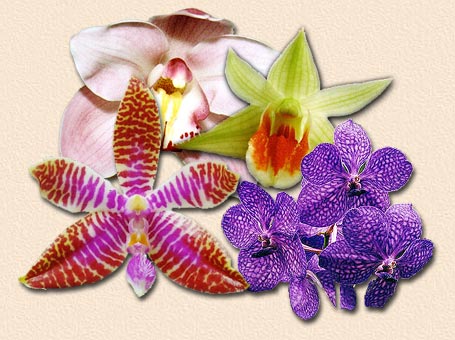 |
Thus, the protohistory of the orchids cultivation in Brazil should remain in the generalities, suppositions and myths..
However, as everything in Brazil, started with the Indians, we should register that they were the firsts "cultivators" or, at least and with a reasonable certitude, the firsts adorers and creators of the myths (cf. my introduction to Francisco Miranda's book "Orchids from The Brazilian Amazon", EXPED, 1996, and "Ciência Hoje", (Science Today), magazine published by the Sociedade Brasileira para o Progresso da Ciência (Brazilian society to the Science Progress, vol. 5, no. 28, Jan./Fev. 1987). Among the tribal rituals there was and, it seems there still is, this one of collecting orchids for magical purpose, medicine, cosmetics, and, may be, even for adorning, that, regarding to the point of view I supported above and delimit in this text, I considered as the first demonstration of orchidophilia. The Archipelago, or better saying, the archipelagos |
During the inaugural lecture of the 15th World Orchids Conference, when I introduced the Brazilian Orchidophilia to the present visitors (cf. the Proceedings of the 15th World Orchids Conference. 1996, ed. Naturalia, pag. 29 ss), in order to simplify and to make easy the comprehension of the panorama I delineated, I declared that the Brazil orchidophile was an archipelago made of five "islands". I settled there a division which coincided with the five big regions in what we use to divide sociological, political and, even, geographically, the country. I called those regions orchidophile provinces, knowing, however that the parts which compose those regions have very specific individualities that differentiate completely every component from the others inside the "province". Or to put in other words, the conviction that the "Archipelago" is formed by many other archipelagos is getting stronger in my mind... |
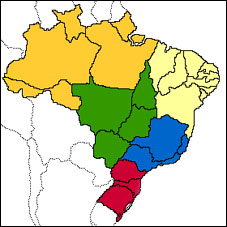 |
I will take the North Region as an example, about which, in that text, I pointed out, carefully, the immensity of the area corresponding to an enormous geographical, cultural diversity and vegetal occurrences, etc. It is important to be emphasized since the master line I took in that work and which seems, until nowadays, valid to me: The regional flowers interest develops around the mainly local occurrences, such as an example, |
|
Cattleya eldorado in Amazonas,
Cattleya violacea in Mato Grosso and Rondônia, Cycnoches, Mormodes, Accacalis, Catasetum in Pará and so on. |
.
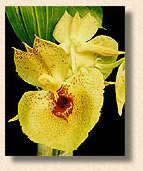
|
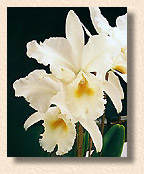 |
The northeast around the
Cattleya labiata and C. granulosa, just to mention two very loved species. |
|
The state of Bahia, that has already had a great orchidophile
tradition with Ernani Urpia and José Martins Catharino, among others, is nowadays an interrogation, in spite of the wonderful and rich orchidaceae flora that competes with those from Minas Gerais and Espírito Santo. It is just enough to enumerate some of its patrimony: C. warneri, elongata, kerri, amethystoglossa, acklandiae, tenuis, etc. Laelia: sincorana, bahiensis, etc. |
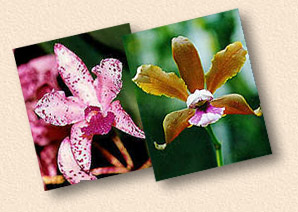 |
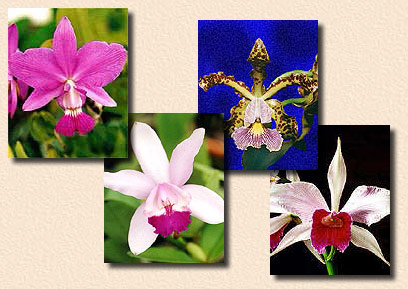 |
The states of Espírito Santo
and Minas Gerais worshiping mainly C. warneri, C. schilleriana, C. walkeriana, Laelia jongheana and the other states in the south, with Laelia purpurata and C. intermedia, |
where
as the states of Rio and São Paulo the orchidophile interest if more eclectic
presenting hybrids in the collections. It is certainly too much schematic this reduction I do of the national orchidophile activity and, also, it is clear that the purpose here is not to reproduce the work presented in the 15th WOC. What I want now is, simply, to stand out the diversity of the interest of the orchidophile societies, in a way related to occurrence and abundance of certain genera and species in a certain region, what make those orchidophile societies very particular beings, "islands of an archipelago". However, as all of us know, the archipelago is not only always made by an assemblage of islands but for the fact that those islands are part of an ensemble, a range. Thus the Brazilian orchidophilia, that does not communicate with itself a lot, has, at least, something to gather itself, the interest for the orchid (*). This is the system that forms the "archipelago"... The existent national organization. It seems to me irrefutable that the Brazilian orchidophilia would earn much if it was organized in national terms. The dimension of Brazil and its cultural, social, geographic, ecological diversity recommend that, also regarding to orchidophilia, we should look for a approaching which reaches the country as a whole. We can not think about a orchidophile Brazil in regional terms exclusively, as well we can not talk about Brazilian orchidophilia without considering a national organization that could carry out certain functions of general character. One of them, the most imminent, is the national system of judgment. There are many other functions of general ambit that could carry forward and justify a "national" orchidophile organization, such as the capacity of agglutinating orchidophile interests in general (included commercial interests), vis-à-vis social institutions and even government and scientific institutions. It is easy to imagine what we get with the intensification of information interchanges in national level, it is enough to consider the experience and diversity that will make richer the orchidophile societies, which will have, for example, access not only the information but also the knowledge of other genera and species, not just the regional ones (this causes a certain monotony in the collections and makes the discussions, endlessly, limited to varieties and nuances of the worshipped plant of this place). When we closely analyze, study and observe the Brazilian orchidophile panorama we feel that there is a mature conscience concerning the necessity of an entity which aggregates the different tendencies that distinguish the local orchidophile societies. There are some initiatives of trans-individualizing the orchidophile interest such as Federação Gaúcha (from the state of Rio Grande do Sul), from the state of Santa Catarina and, some with multi-states characteristics as they join orchidophile societies from São Paulo, Minas Gerais and Goiás, Coordenadoria das Associações Orquidófilas do Brasil - CAOB (Coordination of Brazilian Orchidophile Societies) and, in a different way, as it is still local, OrquidaRIO, an entity with national characteristics. I believe that the formation of this national institution will not delay. To me, just only one consequence would be enough to justify its existence, the creation of a critical orchidophile mass in a national ambit, renovating concepts, enriching cultivators experiences and, mainly, creating a feeling around this varied and dispersed Brazilian richness, without talking about the possibility of having a more solid economical and scientific base for the study, trade and knowledge of our orchids. |
The orchidophile societies
In the current picture, the Brazilian orchidophile societies present certain common characteristics that, could be, schematically, resumed: |
||
a) The financial dilemma - which becomes manifest by the endemic and permanent lack of money, so to speak. The annual contribution is negligible or because associates would not accept to pay more or because the society is afraid of increasing this contribution and lose a great number of associates which would cancel the benefits of a raise. However the members of the direction are conscious that the services offered by the society have not enough quality and quantity.
The associates, on their turn, tend to think that the society does not need more money than their contribution and feel discharged of donating more... For one thing, the rich orchidophiles, as they have access to any information they need have good source of accessories, neither need to be affiliated to a society, nor even use to attend meetings and events; For another thing, the poor ones can not give more than they do... |
||
b) The Sanctioned Organizational Formula - Practically all Brazilian orchidophile societies follow a model of administrative organization and operation schedule: b.1) They always have a board formed by: Presidency, Vice-presidency and Committees: Technical, Associates, Administrative-Financial and, eventually, Show or Events. b.2) Periodically technical meetings take place presenting a lecture of orchids (which theme is not always scientific) and also social meetings offering the possibility of fraternizing and talking about orchids. Some societies use to give courses of initiation or cultivation and do, systematically, sections of judging flowers brought to the meetings. b.3) the great moment of the orchidophile societies is the shows that happen, at least, once a year. Some societies do a great effort to publish periodical magazines concerned the dissemination of the interest on orchids. The most eminent Brazilian examples are the magazines Orquidário, published by OrquidaRIO-SBO and CAOB Boletim, that have already reached quite reasonable level of quality. |
||
We can note, as a matter of fact, the visible and crescent interest in orchid as an objet of pleasure and intellectual enrichment, by the editorial movement concerning this subject, by the increase of the publication of books and even commercial magazines about orchids. Besides, the number of Brazilian sites about orchids multiplied, some with excellent level and international acceptation. Reference works such excellent make CD ROMs about orchids appear frequently allowing us to wait so much for the future of Brazilian orchidophilia.
Artistic and, even, scientific manifestations concerning orchids take shape: botanical drawing and painting, there is already a good quantity of botanical artists and illustrators, generation that comes after artists like Samuel Salvado, Maria Werneck and, mainly, Margareth Mee due to the role she exercised awakening the interest and formation (which has been intensified when the foundation that has her name -Margareth Mee Foundation- has been created), as well as other ways of artistic manifestations such porcelain and ceramics painting. In the philatelic field, not only some artists with great competency and quality have been bringing the Post Company to edit stamps of great quality and beauty but also some philatelic collectors excel, internationally, like the most rewarded José Evair Soares de Sá and Ferdinando Bastos de Souza. I am convinced that those awakening and intensification are the most beneficial results of the 15th World Orchid Conference. Scientific Work and Research. The University. In the universities, botanical gardens and herbariums, with distinction once more to the state of São Paulo (such, for example, the University of Campinas, ESALQ, the Orchid Section of the Botanical Garden), we also see an increase of the interest in orchid as an object of study and research which finishes to healthy reflect on the activities of the orchidophile societies and on rending the orchidophile capable of improving the cultivation, as well as extending his level of the knowledge. Some considerations about the Brazilian orchids trade (**) Is it worth to get into flowers trade, particularly, in orchids trade? As every interrogation, there are many possible answers to the question. An orchid trader would say no, may be afraid of the concurrence. However he does not give up his trade... A trader of correlated products would vehemently says, yes... I think that the best answer would be: "if you know, or if you want to know the activity, if you are able to learn how or if you know how to cultivate plants and love flowers, go ahead because there is no activity more lucrative than doing what pleases us and what we love. The profit, in an economical sense, will finish to appear, because the "other profits" we have already had since the first moment we have came to the decision of following that way". However, how and where start? There is no way except starting... or, in better words, starting to be or to come a cultivator and little by little, discovering if you are skilled in this activity. We also find out that the activity of cultivating ornamental plants is exigent and absorbent although it gives in return the satisfaction of enjoying a wonderful blooming which brings, as a result, a better financial results. It is important to examine the possibilities of the market because it is no use having a good production of good quality flowers if the market does not exist or is mediocre. There are some essential conditions: |
1. Find out the exigencies and necessities of the market and the inclination of the consumers before you offer novelties only justified when the consumer market has already got a certain sophistication, making itself able to enjoy new forms and patterns.
2. Look for having your own production that guarantees a minimum of auto- sufficiency. The current usage in the biggest center of producers is a combination of supplying: flowers produced on their own and as much from other producers, mainly during the peak of production when the offer increases and prices low down. 3. Become a known producer and trader. To get this situation, quality of the products and of the cultivation are essential. |
| Some possible employment of the Orchids production: | |||
| 1. Sale of blooming plants in pots.
2. Rent of blooming plants in pots. 3. Sale of cut-flowers. 4. Sale of small plants. 5. Production and trader of correlate materials such as pots, labels, fertilizer, product for treatment, etc. |
|||
| Some possible usage of the space in a nursery: | |||
| 1. Cultivation | |||
1.1 - The reasonable usage of the room: the maximum utilization.
1.1.1 - Utilization of the stagings and aerial space between them, plants which need more light. 1.1.2 - On the staging, every thing that needs less light. 1.1.3 - Utilization of the space beneath the staging, shade plants that will profit by the residue that drops from the fertilization and will improve humidity conditions. 1.2. - The rent of the space to cultivate plants for other people. |
|||
There are not statistics about the Brazilian trade of flowers and, particularly, of orchids or they are not available or still not published. Although recognizing that there are expressive differences, I present some statistics from United States of America concerning the production and the trade of orchids: |
1. The trade of orchids reached, in 1999, the amount of US$79 millions, versus US$65 millions in 1998, with an increase of 22% year (from this total, the increase of sales corresponds to 4%), becoming, therefore, the second product in the rank of internal sales inside the segment of potted flowers;
2. California is the biggest seller, Florida is the second followed by Hawaii and Illinois; 3. However, Florida is the biggest producer, with 4,7 millions pots against 2,8 millions in California; 4. the producers from Florida sold US$31 millions, against US$24 millions from California which producers got the best prices for their products; 5. On the average, the Californian (US$13,27) got at about the double of the price got by Hawaii's traders, with US$7,29 and Florida, with US$7,10, per individual pot. They were surpassed by those from Illinois, with the average of US$14,90, by pot of adult plant. (fontes, http://www.usda.gov/nass in the section "Today's Reports" e "Orchids", published by American Orchid Society, August 2000, page 790 an October page 1090). |
| With
the empiric knowledge I got as orchidophile and constant visitor of shows and
orchids fairs, I will risk some numbers just following a little the references
above: The biggest producer and consumer centers in Brazil |
|
|
It is
unquestionable that the great producer and consoler market, as a rule in the national
economical activities, is São Paulo, followed by Rio de Janeiro (where, in fact,
the production of orchids in commercial and industrial scale started, in replying
to the production in São Paulo, half craft at the beginning that just started
to follow the model of the former Federal Capital when Adhemar Manarini found
the big commercial nursery, Equilab, from Campinas). We can note that the southeast and south regions, by the cultural tradition which came with the immigrant as well the biggest level of richness, sophistication of taste and interest of leisure have the biggest industrial establishments because the greatest layers of consumers are centralized there. Considering the Brazilian potential because it is one of the greatest sanctuaries of native orchids in the world with genera extremely appreciated by the consumers, because of the advantageous climate conditions, of the low costs of the flowers production, of the great internal market, we can assume and wish that Brazil can be placed soon, among the leaders of the world trade at the side of The Netherlands, Malaysia (where orchids is among the biggest products of exportation), Thailand (the orchids trade is so important in this country that the symbol of the air company, Thai Lines, is a orchid), England, Formosa, Australia, South Africa, Colombia, Peru and Ecuador. In some of those countries, the production reaches such degree and is so cheap, such in The Netherlands, that became the source of supplying the international flower market. Brazil, for instance, imports from those countries, in spite of its enormous possibilities and having peaks of production that low down prices (as occurs in São Paulo, due to the strong Japanese colony, regarding some Asian species Dendrobium, Phalaenopsis e Cymbidium). We do not know the indicators of annual sales but we can take the risk to affirm, based on some observations, on information, on license to import and export, that, at least, this activity surpasses the amount US$5 millions/year and we would add US$2 millions/year by the internal market. On the average, the price of a flowered pot turns around R$8,00 (Brazilian money), in S. Paulo, and, in Rio, R$10,00. In other consumers center with small or nonexistent such Belo Horizonte, Brasília, Goiânia and Salvador, those prices are increased, at least, of 30%, due to the costs of transport and seller. I evaluate the profit of the producer, as well of the seller, at about 25% of the final price.. It seems to make evident that the activity of cultivate orchids can represent an interest, mainly in a market with so great potential such is the Brazilian one and that increases in quite high annual rates. We should point out that this market is away from the saturation and can yet increase a lot. To help the increase of the consumer market, the societies of cultivators or amateurs of orchids, with their meetings and shows, with their publications, sites, magazines etc. are precious instruments. |
||
(*) We do not still think enough about the consequences of the 15th World Orchid Conference since it was an exponential moment of knowledge of Brazilian orchidophiles by Brazilian orchidophiles. I mention two relevant facts to me: in spite of having done a uncommon effort to announce, included personal visits and lectures em almost every Brazilian orchidophile province, we were pleasantly surprised, at the last time, with two attendance: Botanical Garden of Brasilia and the Sociedade Paraense de Orquidófilos - Orchidophile Society of Para (Look on Brazilian map to see how long was the journey to get here with vigorous plants...) Back |
||
|
|
||
